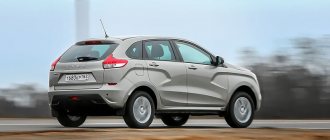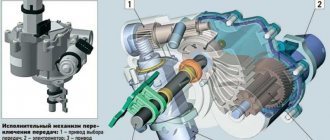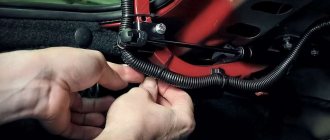Enough time has passed since the launch of mass production to objectively consider all the shortcomings of the Lada Vesta. Although it’s worth starting with the fact that in many ways AvtoVAZ’s new product met consumer expectations:
- good handling for cars of this class;
- roomy trunk and spacious interior (if we compare Vesta with competitors such as Solaris and Rio);
- decent security system;
- stylish appearance;
- many useful standard options implemented by the plant for the first time.
But even the leaders of the global automobile industry do not have ideal cars - there are always pros and cons, and the latter often arouse more interest.
Lada Vesta
Powertrain analysis
The characteristics of the power units that are presented to the attention of Lada Vesta buyers, in general, cannot but please. Currently, the configuration offers three types of engines (for equipping a sedan) and two types of gearboxes.
All three engines have a nominal combustion chamber volume of 1.6 liters. Two of them - eight-valve and sixteen-valve - are products of the AvtoVAZ concern and have a power of 87 and 106 horsepower, respectively. In the past, these engines performed well in many previous models, starting with Kalina. The engines offered by the domestic manufacturer have very decent characteristics for a budget car and relatively rarely require unscheduled maintenance.
The third engine is a development of the Japanese concern Nissan. Having the same engine displacement, it develops slightly more power - 118 hp, due to which it has the highest performance. At the same time, the relatively high price of the engine is fully compensated by fuel consumption, which for this engine model is almost identical to the same indicator for VAZ models. Combined with higher thrust, the Japanese engine creates a more dynamic and comfortable car.
A French unit produced by Renault was used as a gearbox - a five-speed Euro manual transmission. In some versions of the equipment, a robotic analogue of the automatic transmission of the same production is also available. Of course, the proposed AMT is much more convenient than a manual transmission - however, a manual transmission guarantees lower fuel consumption when driving within the city.
Regarding the number of proposed variations of the power unit, here Lada Vesta, without any doubt, occupies an advantageous position. Most of Vesta's direct import competitors (Hyundai Solaris, Kia Rio and Renault Logan) can only offer two engines in combination with a manual transmission and manual transmission. If we take into account the information received from the management of the AvtoVAZ concern, then another engine with a volume of 1.8 liters and a rated power of 122 horsepower will be used to assemble Vesta from 2016.
Minuses
1. Automated transmission (AMT or “robot”)
. AMT is not a classic “automatic machine” and requires a special approach that must be learned. Therefore, this transmission causes negative emotions for many (see reviews about AMT).
2. Knocks and squeaks
. Extraneous noises in the suspension and inside the car. But AVTOVAZ is constantly improving the design, so by now many problems have already been eradicated.
3. Oil pump on 1.8 liter engine
. The weak point is the pressure relief valve of this pump. If it malfunctions, the oil pressure lamp lights up at idle. As a result, as a rule, the pump itself is also covered under warranty replacement.
4. Radio and multimedia
. Freezes, screen calibration, and incorrect operation of CityGuide navigation were detected on the multimedia system (MMS). Sometimes when connecting the phone, the rear view camera stopped working. The same thing was observed after selecting the “AUX” item in the menu. On the radio without a touch screen, not everything was smooth either - on some machines it simply refused to turn on at some point and started working only after a reset.
5. Wiper blades
. They are framed, squeak during operation, and in some cases even scratch the glass.
Let us remind you that, according to experts from the Autoreview magazine, Vesta behaved much better during endurance tests than expected. In her class, Vesta can be called a source of pride.
Keywords: Lada Vesta steering wheel | steering mechanism Lada Vesta | front suspension of Lada Vesta | rear suspension of Lada Vesta | gearbox Lada Vesta | sound insulation of Lada Vesta | cassette player Lada Vesta | Lada Vesta windshield wipers
0 0 0 0 0 0
Share on social networks:
Patency
In the proposed videos of test drives, you can see that the drivers who conducted the tests unanimously agree on one opinion. The cross-country ability of the Lada Vesta is one of its main advantages - the designers did a great job here.
The standard Lada Vesta has a very high ground clearance - when the car is fully loaded with passengers and luggage, its value will be at least 171 mm. The large gap between the bottom of the body and the road surface allows you not only to ignore some obstacles that are impassable for more “down-to-earth” cars, but also not to be afraid of various irregularities inherent in poor quality roads. Lada Vesta is not afraid of curbs, speed bumps, bumps, potholes, most holes and rutted roads. In comparison with foreign analogues, Vesta is much better adapted to operating conditions on Russian roads, and this cannot but be noted as another positive point.
Vesta's suspension is not much different from the designs used in previous models. Hard front and soft rear - this combination guarantees a relatively smooth ride of the car, while allowing the driver to feel the track.
As a disadvantage of this type of suspension assembly, experts note some roll when entering a turn at relatively high speeds. As a result, in theory, this roll can cause the car to overturn during acceleration - however, in practice, the Lada Vesta did not have enough power to achieve such a result during crash tests. However, experts recommend Vesta owners to exercise some caution on roads with a side slope.
Pollution
Vesta owners often have to monitor the cleaning of the engine compartment. This problem is caused by large gaps in the hood lock area, so dirt and water stick to the engine. The problem is solved by installing various seals. The body gets dirty quickly (the reason is the large wheel arches);
the lack of edges on the windshield allows the side windows to quickly become clogged; into the seals on the side windows, dirt gets clogged inside the velvet and leads to scratches: a minus of many cars.
Convenience
An equally important aspect for an experienced driver is the convenience of the purchased car. For many car enthusiasts, this point is even more important than technical characteristics - the longer you can drive without discomfort or interruptions, the faster the journey will end.
The main point in terms of car ergonomics is the interior configuration. Considering the largest overall dimensions in the class (because of them, the Lada Vesta sedan is classified as class B+), the car’s interior is somewhat more spacious. Some publications specifically sent very tall drivers to test drive the new model - and even they were generally satisfied. A person of average height will be comfortable in a car both behind the wheel and in any passenger seat. A person who is significantly taller than average may feel slight discomfort due to the roof hanging over his head - however, this problem appears in all budget B class cars.
Many drivers who conducted test drives also appreciated the high-quality assembly of the seats and armchairs. Their ergonomics have been significantly improved – even in the basic “Classic” configuration. The rear sofa has three headrests for three passengers (although some critics noted the reduced height of the backrest of the rear sofa).
While listing the pros and cons, we must not forget about the shortcomings. The steering column, although adjustable for reach, is quite difficult to use due to the adjuster being too small. The driver's seat armrest included in the Comfort package, according to some drivers, only gets in the way.
Overall, the model makes a good impression. A good air conditioner, installed already in the basic configuration; a powerful audio system with a radio (in the “Lux” configuration, when choosing the “Multimedia” package, it is replaced by a touch gadget) and the presence of heated front seats already in the middle configuration makes this car really convenient for the owner.
Malfunctions and their elimination
Poor assembly, imperfect design, and incorrect handling of mechanisms often lead to broken levers.
For repair you need:
- dismantle the chair;
- remove the back, trim;
- Replace the plastic lever with a new one.
After everything has been done, assemble the structure in the reverse order. The process is simple, but labor-intensive.
Safety
Don't forget about car safety. This parameter directly affects what the chance of avoiding an accident in a critical situation will be, as well as how high the damage received will be if it is not possible to avoid an accident.
Already in the basic configuration, the car is equipped with electronic devices to ensure the safety of the driver and passengers, as well as other road users. The car is equipped with numerous stability control systems (including ABS and ESC), which automatically limit speed at a dangerous angle of roll or skid. There is also an ERA-GLONASS system that will automatically send a message to the rescue service in the event of an accident.
Already in the basic configuration of the Lada Vesta, as can be seen in the photo, there is a driver’s airbag. The higher the trim level, the more airbags are located in the car (“Comfort” adds an airbag for the front passenger, “Lux” adds side airbags).
The only drawback identified during the inspections was the not entirely correct operation of the ESC stability system. It continued to reduce engine thrust even after the car exited a corner, reducing driving dynamics and often forcing test drivers to turn it off manually. The manufacturer assured that this flaw has been corrected.
Overall, the car makes a good impression. Even those who did not expect outstanding feats from the domestic manufacturer were satisfied. Naturally, the price of the Lada Vesta is slightly higher than for previous models due to richer trim levels and more impressive capabilities - however, the average cost of Vesta compared to competing foreign cars in similar trim levels will be consistently lower, although not by much.
More details about Lada “Vesta” cars
Disadvantages of the car
Value for money
Despite the fact that in general the car is one of the best representatives of the domestic automobile industry, the materials and technologies used do not justify the inflated price tag of 500,000 rubles or more . Cars from other manufacturers offer more functionality at this price and also have better build quality.
Robotic gearbox
Developed in the depths of AvtoVAZ, the robotic gearbox is considered one of the most important disadvantages of this car model, since automatic switching is very slow. This unpleasant feature is associated with the settings of the gearbox unit. In order for the clutch disc linings to last as long as possible, it was simply necessary to slow down the shift algorithm.
Insufficient sound insulation
Although the Lada Vesta can provide the driver with the necessary level of comfort, in the case of rear passengers it is not so simple. The rear wheel arches are practically devoid of sound insulation and passengers can hear noise quite well and feel vibration when driving.











